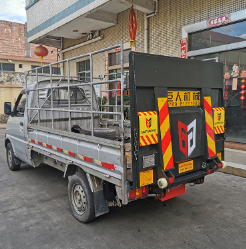
When selecting a suitable truck tailboard, multiple factors need to be considered comprehensively to ensure that the tailboard can meet specific needs and improve transportation efficiency. The following are several key steps for selecting a truck tailboard based on demand:
1. Clearly define the size and load requirements of the truck
Truck size: Measure the width, length, and ground clearance of the truck compartment to ensure that the selected tailboard size matches the truck. The width of the tailboard should be less than or equal to the width outside the carriage, preferably slightly less than the width inside the carriage, in order to install anti-collision ear plates.
Load requirements: Select the appropriate tailboard tonnage based on the weight of the transported goods. The load-bearing capacity of the tailboard should be slightly greater than the actual weight of the transported goods to ensure safe use.

2. Consider the type of goods and loading and unloading scenarios
Goods type: Different types of goods have different requirements for the tailboard. For example, fragile or valuable items may require a smoother loading and unloading process, while heavy cargo requires a tailboard with stronger load-bearing capacity.
Loading and unloading scenarios: The usage environment of the tailboard is also an important factor in the selection. In urban logistics, vertical tailboards may be more popular due to their vertical lifting characteristics; In scenarios where space saving is required, a folding tailboard may be more suitable.
3. Compare the material and type of the tailboard
Material: Common tailboard materials include steel, aluminum, composite materials, and plastic. Steel tailboards are cheap and durable, but they are heavier in weight; Aluminum tailboards are lightweight and environmentally friendly, but they come at a higher price. Composite tailboards have the advantages of light weight and high strength.
Type: Cantilever tailboard has a wide range of applications and is easy to operate; Folding tailboard saves space and is suitable for cold chain logistics and dedicated logistics; Vertical tailboards are suitable for fast loading and unloading in urban logistics.
4. Evaluate budget and services
Budget: Select the appropriate tailboard based on the budget range. The prices of tailboards of different materials, types, and brands vary greatly, and should be selected based on actual needs and economic capabilities.
Service: Understand the service quality and after-sales service scope of the tailboard supplier, including installation, commissioning, maintenance, etc., to ensure timely technical support and guarantee for the tailboard during use.
In summary, selecting a suitable truck tailboard requires comprehensive consideration of multiple factors such as truck size, load requirements, cargo type and loading and unloading scenarios, tailboard material and type, as well as budget and service. Through comprehensive evaluation, the most suitable truck tailboard for one's own needs can be selected.

Professional to provide security
for modern logistics
A new company that efficiently handles
and unloads equipment
Please do not hesitate to contact us
0769-81251088

Add friend consultation